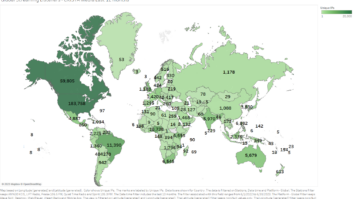For decades, audio processing for radio has had two goals: maximizing modulation on AM to increase station coverage areas and masking noise on FM.
The results may please the keepers of the bottom line; but Andy Laird, vice president/chief technology officer of Journal Broadcast Group, says the “golden ears” contingent of the audience has never been happy with the compromises inherent in today’s intensive multi-band audio processors.
(click thumbnail)‘For blend to operate properly the subjective levels between analog and digital must match,’ Laird said, ‘and by clever gain structure design from Ibiquity you have an extra 6 dB of headroom on the digital side.’ (The answer to ‘Why?’ in his slide is ‘Because of blend.’)
“I like to call them the ‘aesthetic police,'” he told a session at the NAB Radio Show in Philadelphia. “They hate it.”
Fewer compromises
There’s good news for the self-proclaimed audio cops, said Laird and co-presenter, Frank Foti, founder and president of processor manufacturer Omnia.
The arrival of HD Radio on the broadcast scene will eliminate the need for many of those compromises, removing the pre-emphasis built in to the present-day FM system, restoring lost high frequencies and removing the noise floor that plagues both AM and FM analog broadcasting.
Before broadcasters can take advantage of the benefits of HD Radio, though, Laird says they need to make the most of their current processing.
Among the tips he offered for quality-conscious broadcasters is to be extremely careful with audio levels before they hit the processor. That means dubbing music and production elements with consistent levels, using a mono VU meter to read levels, properly calibrating input levels to the console and using quality mic and telephone processors.
Laird says attention will also have to be paid to the number of codecs audio passes through en route to the listener. While the HDC codec used in HD Radio is compatible with most of the compression used in typical satellite feeds and MiniDisc audio, for instance, Laird said it falls apart when audio that’s been stored in MP3 format is transmitted at a low bit rate.
“For AM HD, it sounds like an MP3 on steroids,” he said, noting that “the e-mail delivery method of spots as MP3 files is going to have to go away.”
Foti shared tips from his career in the processing business, noting the many links in a station’s audio chain, including the STL path and the exciter, that can affect the finished product just as much as the processor itself.
He recommends using the stereo generator in the audio processor instead of in the exciter whenever possible, then feeding the MPX input to the exciter to allow for composite clipping if desired.
So what’s different about processing for HD Radio, assuming a station is taking care of those basic elements of clean audio?
“Really nothing,” said Laird, “other than that you’re going to need a modern processor that has a (HD) sidechain and an AES (digital) input,” as well as one that’s designed to work with a 5 kHz audio bandwidth for AM use.
Noise-be-gone
Laird said the biggest difference when it comes to HD Radio on the AM band is “there’s no noise to cover up.” That’s been an eye-opener for his company, since it means, for instance, that Journal’s WTMJ(AM), Milwaukee now enjoys the same signal-to-noise ratio in Green Bay, 100 miles north of its home market, that it does in downtown Milwaukee.
“All of a sudden,” he said, “your need to cover noise with processing is gone.”
There are tradeoffs to be made, though, especially at the relatively low bit rates used for AM HD signals and for FM stations that multicast. Laird says those low-bit rate signals are susceptible to digital artifacting, and – as with any digital audio – absolutely intolerant of any clipping.
“You have clipping in your system, you’re going to hear it,” he said.
Another challenge comes with matching audio levels for the analog and digital sides of a hybrid HD Radio signal. Laird recommends using telephone audio, with no high-frequency content, when matching levels between the analog and digital broadcasts.
Equally critical, he says, is the need for precise timing of the delay between the analog and digital sides. A mismatch of as little as 3/100 of a second can cause an audible echo as a radio blends from analog to digital and back, Laird says.
Foti says the complexity of the HDC codec makes the use of a modern processor even more important.
“We like to feel that the audio processor is operating more like a partner with the codec,” he said. By removing audio content that will be masked anyway in the codec’s algorithms, Foti said a well-designed processor can help the codec operate more efficiently.
Foti hopes the coming of HD Radio will wean broadcasters of some of their bad habits where processing is concerned. Because HD receivers won’t be able to switch instantaneously from one digital signal to another, “you can’t directly compare loudness” between two HD signals, he said, holding out hope that the loudness wars that have afflicted many markets will disappear as a result.
The delay inherent to HD Radio gives processor designers some new opportunities, as well. Foti says Omnia has developed a “look-ahead” clipping algorithm that modifies itself to reduce intermodulation distortion (IMD) from clipping.
Foti himself looked ahead to two more technologies that are just beginning to find their way into radio: multicasting on HD FM and 5.1 surround.
For multicasting, Foti says Omnia’s “SENSUS” algorithm, part of the company’s new Omnia Multicast processor, changes its architecture in response to the type of content it’s processing, removing frequency ranges that won’t be broadcast (on very low-bit rate spoken-word material, for example) for more efficient codec operation.
On the controversial issue of 5.1 surround, where Foti has publicly and loudly aligned himself with Fraunhofer’s MPEG standard and against the competing Neural system, Foti offered demonstrations of audio that had been processed through each system, expressing concern that the Neural system leaves excessive amounts of L-R content that can cause multipath and mono-compatibility issues for stations.












